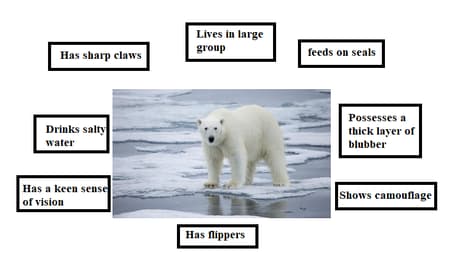Anita Paul, Seema Sinha, Karuni Subrahmanyam and, Deepika Parashari Solutions for Exercise 1: Put on your THINKING CAP!
Anita Paul Science Solutions for Exercise - Anita Paul, Seema Sinha, Karuni Subrahmanyam and, Deepika Parashari Solutions for Exercise 1: Put on your THINKING CAP!
Attempt the practice questions from Exercise 1: Put on your THINKING CAP! with hints and solutions to strengthen your understanding. New Science Spark Book 7 solutions are prepared by Experienced Embibe Experts.
Questions from Anita Paul, Seema Sinha, Karuni Subrahmanyam and, Deepika Parashari Solutions for Exercise 1: Put on your THINKING CAP! with Hints & Solutions
Given below is a picture of a polar bear. A number of adaptations are written in the boxes around it. Put a tick mark in the box if the polar bear has that particular adaptation.

All of these animals have special features that help them to survive in their environment. Put each animal in the column where it belongs. Some animals may belong to more than one column.
Penguin, Macaw, Lion-tailed macaque, Toucan, Poison arrow frog, Monkey, Hoolock gibbon.
| Has a prehensile tail | Has a beak | Can climb trees | Shows camouflage | Is poisonous/ harmful to touch |
In the space provided beside each adaptation, write how it is useful to the animal.
Loud communication among lion-tailed macaques _____.In the space provided besides each adaptation, write how it is useful to the animal.
Prehensile tail in monkeys _____.
In the space provided besides each adaptation, write how it is useful to the animal.
Large ears of an elephant _____
In the space provided beside each adaptation, write how it is useful to the animal.
The trunk of an elephant _____.In the space provided beside each adaptation, write how it is useful to the animal.
Camouflage in frogs _____. (Attraction/Hide)In the space provided besides each adaptation, write how it is useful to the animal.
Flippers of a penguin _____.